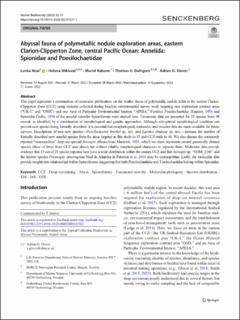| dc.contributor.author | Neal, Lenka | |
| dc.contributor.author | Wiklund, Helena | |
| dc.contributor.author | Rabone, Muriel | |
| dc.contributor.author | Dahlgren, Thomas Gunnar | |
| dc.contributor.author | Glover, Adrian G. | |
| dc.date.accessioned | 2023-09-20T08:37:44Z | |
| dc.date.available | 2023-09-20T08:37:44Z | |
| dc.date.created | 2022-09-26T14:22:37Z | |
| dc.date.issued | 2022 | |
| dc.identifier.citation | Marine Biodiversity. 2022, 22 . | en_US |
| dc.identifier.issn | 1867-1616 | |
| dc.identifier.uri | https://hdl.handle.net/11250/3090703 | |
| dc.description.abstract | This paper represents a continuation of taxonomic publications on the benthic fauna of polymetallic nodule fields in the eastern ClarionClipperton Zone (CCZ) using material collected during baseline environmental survey work targeting two exploration contract areas (“UK-1” and “OMS”) and one Area of Particular Environmental Interest, “APEI-6.” Families Poecilochaetidae Hannerz, 1956 and Spionidae Grube, 1850 of the annelid suborder Spioniformia were studied here. Taxonomic data are presented for 25 species from 98 records as identified by a combination of morphological and genetic approaches. Although sub-optimal morphological condition can prevent new species being formally described, it is essential that morphological, molecular, and voucher data are made available for future surveys. Descriptions of two new species—Poecilochaetus brenkei sp.nov.andLaonice shulseae sp. nov.—increase the number of formally described new annelid species from the areas targeted in this study to 15 and CCZ-wide to 46. We also discuss the commonly reported “cosmopolitan” deep-sea spionid Aurospio dibranchiata Maciolek, 1981, which we show represents several genetically distinct species (three of these from CCZ area alone) but without reliable morphological characters to separate them. Molecular data provide evidence that 15 out of 25 species reported here have a wide distribution within the eastern CCZ and that Aurospio sp. “NHM_2186” and the known species Prionospio amarsupiata Neal & Altamira in Paterson et al. 2016 may be cosmopolitan. Lastly, the molecular data provide insights into relationships within Spioniformia, suggesting that both Poecilochaetidae and Trochochaetidae belong within Spionidae. | en_US |
| dc.description.abstract | Abyssal fauna of polymetallic nodule exploration areas, eastern Clarion-Clipperton Zone, central Pacific Ocean: Annelida: Spionidae and Poecilochaetidae | en_US |
| dc.language.iso | eng | en_US |
| dc.rights | Navngivelse 4.0 Internasjonal | * |
| dc.rights.uri | http://creativecommons.org/licenses/by/4.0/deed.no | * |
| dc.subject | Taksonomi | en_US |
| dc.subject | Taxonomy | en_US |
| dc.title | Abyssal fauna of polymetallic nodule exploration areas, eastern Clarion-Clipperton Zone, central Pacific Ocean: Annelida: Spionidae and Poecilochaetidae | en_US |
| dc.title.alternative | Abyssal fauna of polymetallic nodule exploration areas, eastern Clarion-Clipperton Zone, central Pacific Ocean: Annelida: Spionidae and Poecilochaetidae | en_US |
| dc.type | Journal article | en_US |
| dc.type | Peer reviewed | en_US |
| dc.rights.holder | © Crown 2022 | en_US |
| dc.description.version | publishedVersion | en_US |
| cristin.ispublished | true | |
| cristin.fulltext | original | |
| cristin.qualitycode | 1 | |
| dc.identifier.doi | 10.1007/s12526-022-01277-1 | |
| dc.identifier.cristin | 2055545 | |
| dc.source.journal | Marine Biodiversity | en_US |
| dc.source.volume | 22 | en_US |
| dc.source.pagenumber | 48 | en_US |
| dc.subject.nsi | VDP::Matematikk og naturvitenskap: 400 | en_US |
| dc.subject.nsi | VDP::Mathematics and natural scienses: 400 | en_US |

